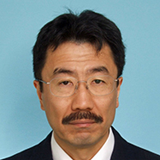|
Affiliation |
Graduate School of Engineering Science Department of Life Science Life Science Course |
|
Date of Birth |
1963 |
|
Laboratory Address |
1-1 Tegata Gakuen-machi, Akita 010-8502, Japan |
|
Laboratory Phone number |
+81-18-889-2440 |
|
Laboratory Fax number |
+81-18-889-2440 |
|
Homepage URL |
|
|
Mail Address |
|
FUJIWARA Kenshu
|
|
|
Research Interests 【 display / non-display 】
-
Natural Products
-
Synthetic Chemistry
-
Chemistry of Bio-molecules
-
Organic Chemistry
Graduating School 【 display / non-display 】
-
1982.04-1986.03
Tohoku University Faculty of Science Graduated
Graduate School 【 display / non-display 】
-
1988.04-1991.03
Tohoku University Graduate School, Division of Natural Science Doctor's Course Completed
-
1986.04-1986.03
Tohoku University Graduate School, Division of Natural Science Master's Course Completed
Campus Career 【 display / non-display 】
-
2016.04-Now
Akita University Graduate School of Engineering Science Department of Life Science Professor
-
2015.10-2016.03
Akita University Graduate School of Engineering and Resource Science Department of Life Science Professor
External Career 【 display / non-display 】
-
2009.10-2010.03
Niigata University
Research Areas 【 display / non-display 】
-
Nanotechnology/Materials / Synthetic organic chemistry
-
Nanotechnology/Materials / Structural organic chemistry and physical organic chemistry
-
Life Science / Bioorganic chemistry
-
Life Science / Bioorganic chemistry
-
Nanotechnology/Materials / Chemistry and chemical methodology of biomolecules
Research Achievements 【 display / non-display 】
-
Total synthesis of selaginellin A
K. Fujiwara, T. Itagaki, T. Tokiwano
Tetrahedron Letters ( Tetrahedron Letters ) 79 153295 2021.08 [Refereed]
Research paper (journal) Domestic Co-author
The total synthesis of selaginellin A, isolated from Selaginella tamariscina, was achieved through an eight-step process including a Diels-Alder reaction, formation of a quinone methide moiety and dehydrogenative aromatization. The NMR spectra collected for different samples of synthetic selaginellin A initially showed irregular peak shapes and variable chemical shifts for the signals of the phenol-substituted quinone methide moiety under neutral conditions. After detailed NMR analysis, it was found that the addition of a trace amount of trifluoroacetic acid accelerated the tautomerism of the phenol-substituted quinone methide moiety and improved the reproducibility of the chemical shifts of synthetic selaginellin A.
-
Y. Aki, Y. Katsumata, H. Kakihara, K. Nonaka, K. Fujiwara
PLoS ONE ( PLoS ONE ) 16 ( 4 April 2021 ) e0250416 2021.04 [Refereed]
Research paper (journal) Domestic Co-author
There is a continuous demand to improve monoclonal antibody production for medication supply and medical cost reduction. For over 20 years, recombinant Chinese hamster ovary cells have been used as a host in monoclonal antibody production due to robustness, high productivity and ability to produce proteins with ideal glycans. Chemical compounds, such as dimethyl sulfoxide, lithium chloride, and butyric acid, have been shown to improve monoclonal antibody production in mammalian cell cultures. In this study, we aimed to discover new chemical compounds that can improve cell-specific antibody production in recombinant Chinese hamster ovary cells. Out of the 23,227 chemicals screened in this study, 4-(2,5-dimethyl-1H-pyrrol-1-yl)-N-(2,5-dioxopyrrolidin-1-yl) benzamide was found to increase monoclonal antibody production. The compound suppressed cell growth and increased both cell-specific glucose uptake rate and the amount of intracellular adenosine triphosphate during monoclonal antibody production. In addition, the compound also suppressed the galactosylation on a monoclonal antibody, which is a critical quality attribute of therapeutic monoclonal antibodies. Therefore, the compound might also be used to control the level of the galactosylation for the N-linked glycans. Further, the structure-activity relationship study revealed that 2,5-dimethylpyrrole was the most effective partial structure of 4-(2,5-dimethyl-1H-pyrrol-1-yl)-N-(2,5-dioxopyrrolidin-1-yl) benzamide on monoclonal antibody production. Further structural optimization of 2,5-dimethylpyrrole derivatives could lead to improved production and quality control of monoclonal antibodies.
-
Total synthesis of selaginellin S
Kenshu Fujiwara, Takaya Itagaki, Yoshihiko Kondo, Uichi Akiba, Tetsuo Tokiwano
Tetrahedron Letters ( Tetrahedron Letters ) 61 ( 25 ) 152031 2020.06 [Refereed]
Research paper (journal) Domestic Co-author
-
An Approach to a 2-Hydroxy-3-phenyldibenzofuran Skeleton Based on Rh(PPh3)3Cl-Catalyzed [2+2+2] Cycloaddition Between a 1-Ethynyl-2-(Ethynyloxy)benzene and an (Alkoxyethynyl)benzene
Daisuke Sato, Kenshu Fujiwara, Yoshihiko Kondo, Uichi Akiba, Tetsuo Tokiwano
HETEROCYCLES 101 ( 2 ) 417 - 422 2020.01 [Refereed]
Research paper (journal) Domestic Co-author
-
Molecular Wires with Controllable π‐Delocalization Incorporating Redox‐Triggered π‐Conjugated Switching Units.
Wataru Nojo, Hitomi Tamaoki, Yusuke Ishigaki, Ryo Katoono, Kenshu Fujiwara, Takanori Fukushima, Takanori Suzuki
ChemPlusChem 84 ( 6 ) 634 - 642 2019.07 [Refereed]
Research paper (journal) Domestic Co-author
◆Original paper【 display / non-display 】
Grant-in-Aid for Scientific Research 【 display / non-display 】
-
Grant-in-Aid for Scientific Research(C)
Project Year: 2023.04 - 2026.03
-
Grant-in-Aid for Scientific Research(C)
Project Year: 2018.04 - 2021.03
-
Grant-in-Aid for Scientific Research(B)
Project Year: 2015.04 - 2019.03
-
Grant-in-Aid for Scientific Research(C)
Project Year: 2015.04 - 2018.03
-
Grant-in-Aid for Scientific Research(C)
Project Year: 2012.04 - 2015.03
Presentations 【 display / non-display 】
-
Total Synthesis of Pectenotoxin-2
Kenshu Fujiwara
2011 Asian Core Program Lectureship Award Lecture (Hsinchu, Taiwan) 2012.11 - 2012.11 Asian Core Program
Academic Activity 【 display / non-display 】
-
2024.11-2024.12
-
2024.03-2024.09
-
2024.02-2025.01
-
2023.02-2024.01
-
2022.02-2023.01


